The Best Tajin Seasoning Substitute (+ alternatives)
This iconic Mexican chilli lime seasoning is surprisingly tart, smoky, savoury, slightly spicy, and sometimes tricky to find. Try the best tajin seasoning substitute recipe or the citrus-free, all-natural and non-spicy versions.
Tajín is an iconic Mexican chilli lime seasoning. It is tart, a bit smoky and has a mild spicy kick.
The seasoning blend is available in over 30 countries. But it’s not available in my local grocery store. And if you’re lucky enough to track it down in my neighbourhood, it’s super expensive.
Luckily, this simple blend of dried red chillies, dehydrated lime and salt is easy to substitute at home.
I went through numerous taste tests to find the best Tajín Seasoning alternatives to suit your palate and pantry. And then I just kept right on taste testing. The stuff is utterly delicious!
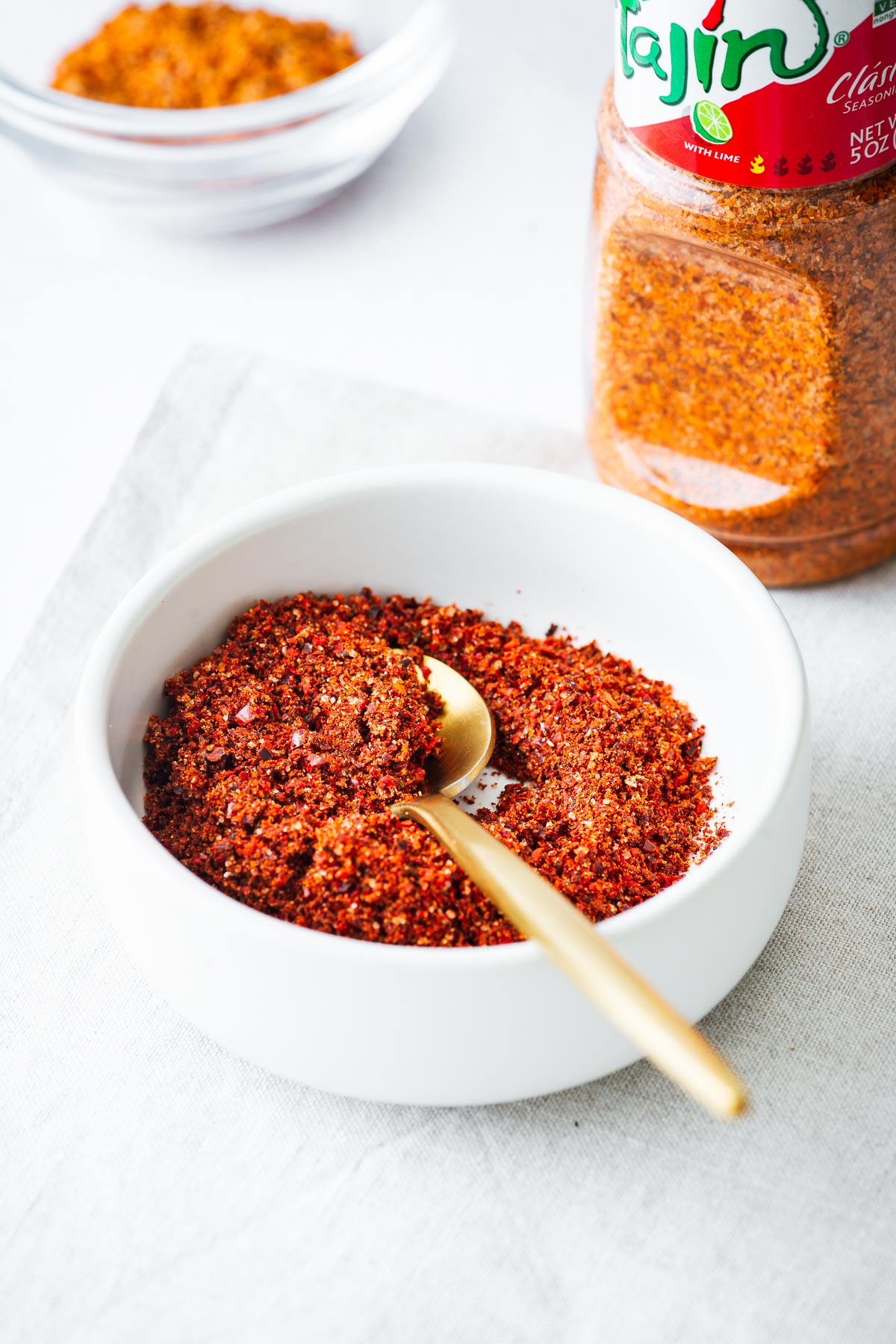
What is Tajín Clásico Seasoning?
Tajín Clásico Seasoning is a popular Mexican chilli lime seasoning, often referred to simply as tajin. It is a mildly spicy seasoning blend of chillies and lime.
The Tajín product line also includes a reduced sodium version, a mild hot sauce, a fruity chamoy hot sauce and habanero seasoning.
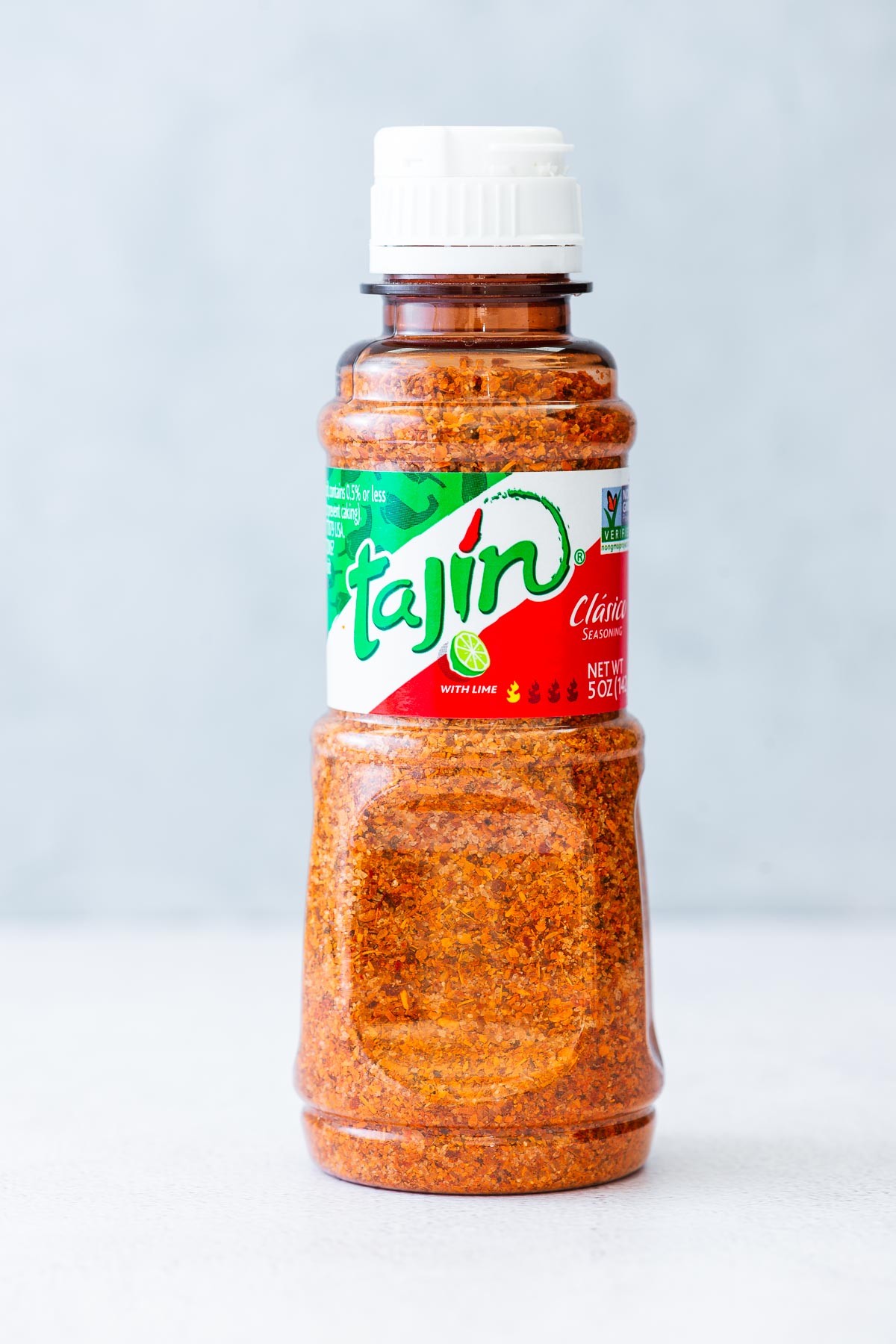
A brief history of Tajín
Horacio Fernandez founded the Mexican company, also called Tajín, in 1985. He was intent on recreating his grandmother’s chilli sauce in a powder form.
The resulting Tajín Seasoning reached the United States in 1993. It was considered an “authentic chili lime seasoning for Latinos and other communities”.
Thanks to its success in Mexico and the United States, Tajín is now available in over 30 countries.
What does Tajín taste like?
Tajín Clásico Seasoning is sour, smoky, savoury and slightly spicy.
While the main ingredient of Tajín is chilli peppers, it is surprisingly tart thanks to the dehydrated lime juice, and even more so the citric acid.
The mild chilli peppers give Tajín a smoky, slightly spicy flavour.
Tajín ingredients
The main ingredients of Tajín Clásico Seasoning are dried chilli pepper, sea salt, citric acid, and dehydrated lime juice.
Citric acid, not always listed as an ingredient, is immediately recognisable in the taste.
Some product labels – in the US and Mexico – list ingredients as: “chili peppers, sea salt, dehydrated lime juice, silicon dioxide (to prevent caking)”.
However, other labels specify citric acid in its ingredient list: “chili peppers, sea salt, citric acid, contains 0.5% or less of dehydrated lime juice, silicon dioxide (to prevent caking)”.
To create the best substitutes at home, let’s consider each ingredient in Tajín Seasoning.
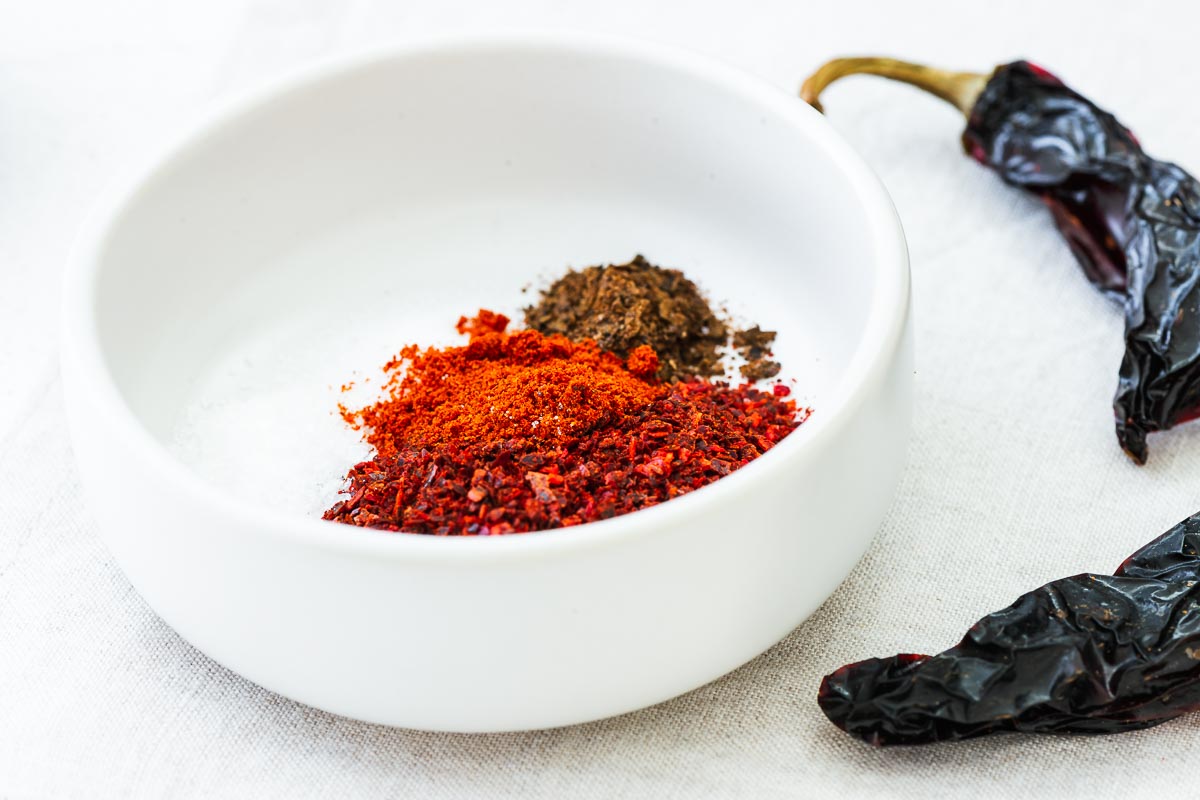
Chilli peppers
The best dried chillies for a Tajín substitute are mild Mexican peppers with a hint of smokiness, like pasilla or guajillo chile powder. Or use chiles de árbol for a spicier version. You can also use a blend of the three types.
But these dried chile powders can be tricky to track down outside Mexico and the US. So, try another mild, smoky chilli flake like Aleppo pepper flakes or gochugaru. You can even use standard red pepper flakes or a combination of cayenne pepper powder and smoked paprika.
Or stick to only paprika if you want a non-spicy Tajín Seasoning substitute.
Sea salt
The seasoning label specifies sea salt, but you can use any salt you have at home.
Tajín Seasoning is not overly salty.
Citric acid
Citric acid gives limes their sour taste. It comprises as much as 8% of the dry weight.
While it is possible to make citric acid from lime juice, most commercial citric acid uses a microbial process to derive it from a strain of black mould.
You can find food-safe citric acid in most grocery stores.
Citric acid is a prominent flavour in Tajín, giving the spice blend a tangy flavour and sherbet-like candy quality. It explains why the label comes with the warning: “This is not candy”.
Dehydrated Lime Juice
The Tajín Seasoning I have at home has 0.5% or less dehydrated lime juice in the seasoning mix, according to the product label.
Most of the candy-like sourness is thanks to citric acid.
So, we only need to introduce a hint of lime juice for our tajin copycat recipe.
The best substitutes for Tajín Seasoning
With the detailed ingredient information in the previous section, we can create a variety of Tajín Seasoning substitutes to fit your pantry and requirements.
The best tajin seasoning substitutes are:
- Homemade tajin seasoning substitute (copycat recipe)
- Shop-bought chilli lime seasoning
- Chilli flakes, salt and lime zest
- Chilli powder, salt and sumac
- Smoked paprika, salt and lime
1. Homemade Tajín Seasoning substitute (copycat recipe)
For the best Tajín Seasoning substitute, mix
- a tablespoon of mild chilli powder or fine flakes,
- ¼ teaspoon of smoked paprika (or smoked chipotle for more heat),
- ½ teaspoon of ground salt,
- ¼ teaspoon citric acid powder,
- ¼ teaspoon ground black lime powder or lime zest.
You can omit the smoked paprika if your chilli powder has a smoky taste (like guajillo chile powder or chipotle powder).
If you don’t have smoky dried chilli flakes, try a mix of cayenne pepper powder and smoked paprika.
You can omit the citric acid, but the chilli lime seasoning won’t have the same sherbet-like quality as Tajín.
For the lime component, you can also use dehydrated lime juice. But ground black lime powder or lime zest works great and can be made from fresh limes at home.
If you don’t need a dry seasoning blend (like if you plan to add the Tajín to guacamole), use a squeeze of fresh lime juice or lemon juice.
Black limes are whole dehydrated limes. Learn how to make black limes and ground black lime powder at home.
Or follow the instructions to make your own dried lime zest.
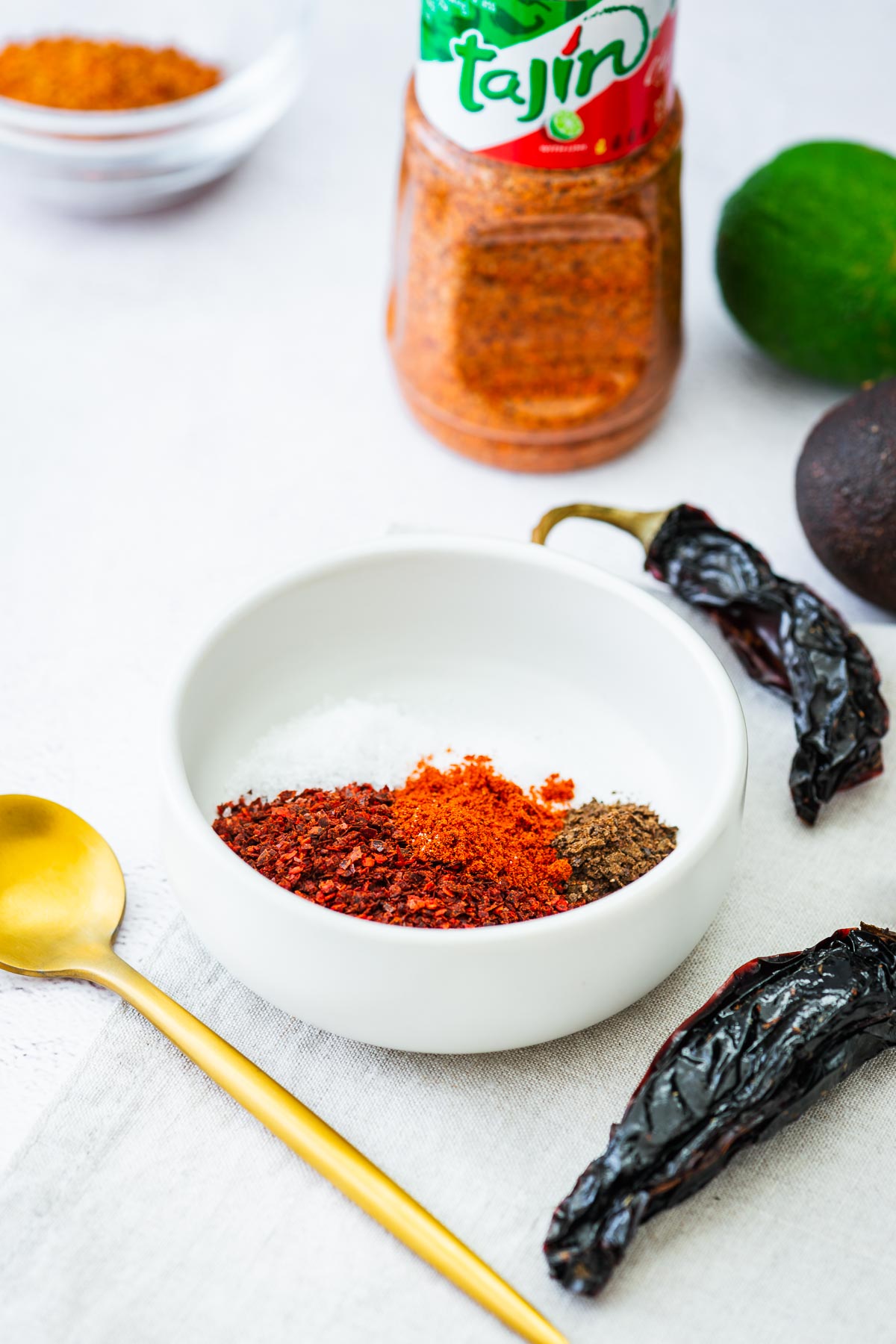
2. Chilli lime seasoning (best store-bought alternative)
Another good alternative is any off-the-shelf chilli lime seasoning, like Trader Joe’s Chile Lime Seasoning Blend.
Some shop-bought seasonings may also have onion powder or garlic powder. So read the ingredient labels to find the closest match to Tajín Seasoning ingredients. The first prize is a seasoning containing only chilli peppers, sea salt, citric acid, and lime.
3. Chilli flakes, salt and citrus zest (all-natural substitute)
Mix a tablespoon of fine chilli flakes with half a teaspoon of ground sea salt and half a teaspoon of lime or lemon zest for a quick and easy substitute for Tajín.
This mix is a good substitute made from widely available natural ingredients. But you can add a pinch of citric acid for that Tajín tang if you want.
4. Chilli powder, salt and sumac (citrus-free substitute)
Sumac is not an ingredient in Tajín Seasoning, nor is it common in Mexican cuisine. But it has a fruity tartness that makes a great substitute for lime zest or lime powder. This is the best alternative for those who can’t have citrus.
Mix one tablespoon of chilli powder (or fine chilli flakes) with half a teaspoon of salt and half a teaspoon of sumac powder.
5. Smoked paprika, salt and lime (non-spicy alternative)
This spice blend is the best non-spicy substitute for Tajín. It is smoky, citrusy and an all-around delicious seasoning.
Mix one tablespoon of smoked paprika with half a teaspoon of ground sea salt and half a teaspoon of dehydrated lime juice powder, ground black lime powder, or lime zest.
Add a pinch of citric acid if you want that classic Tajín Seasoning tang.
How to use Tajín Seasoning (or substitute)
Tajín Seasoning goes well with most Mexican food. But this versatile seasoning mix can do so much more. Here are a few of my favourite ways to use your Tajín Clásico or tajin substitute.
Sprinkle it over:
- cucumber slices for a healthy afternoon snack,
- fresh fruits – like mango and pineapple slices – and fruit salads for a spicy kick (the original use case),
- grilled whole sweetcorn spread generously with butter, or
- cocktails and glass rims, it’s perfect for a margarita or bloody mary.
You can also use it as:
- a dry rub for meat,
- sweet potato seasoning (it pairs so well with the sweet taste), or
- any vegetable seasoning,
- to spice up your next loaded guacamole.
It is especially great to revive day-old or frozen guacamole!
Let me know in the comments below how you like to use your homemade chilli lime seasoning!
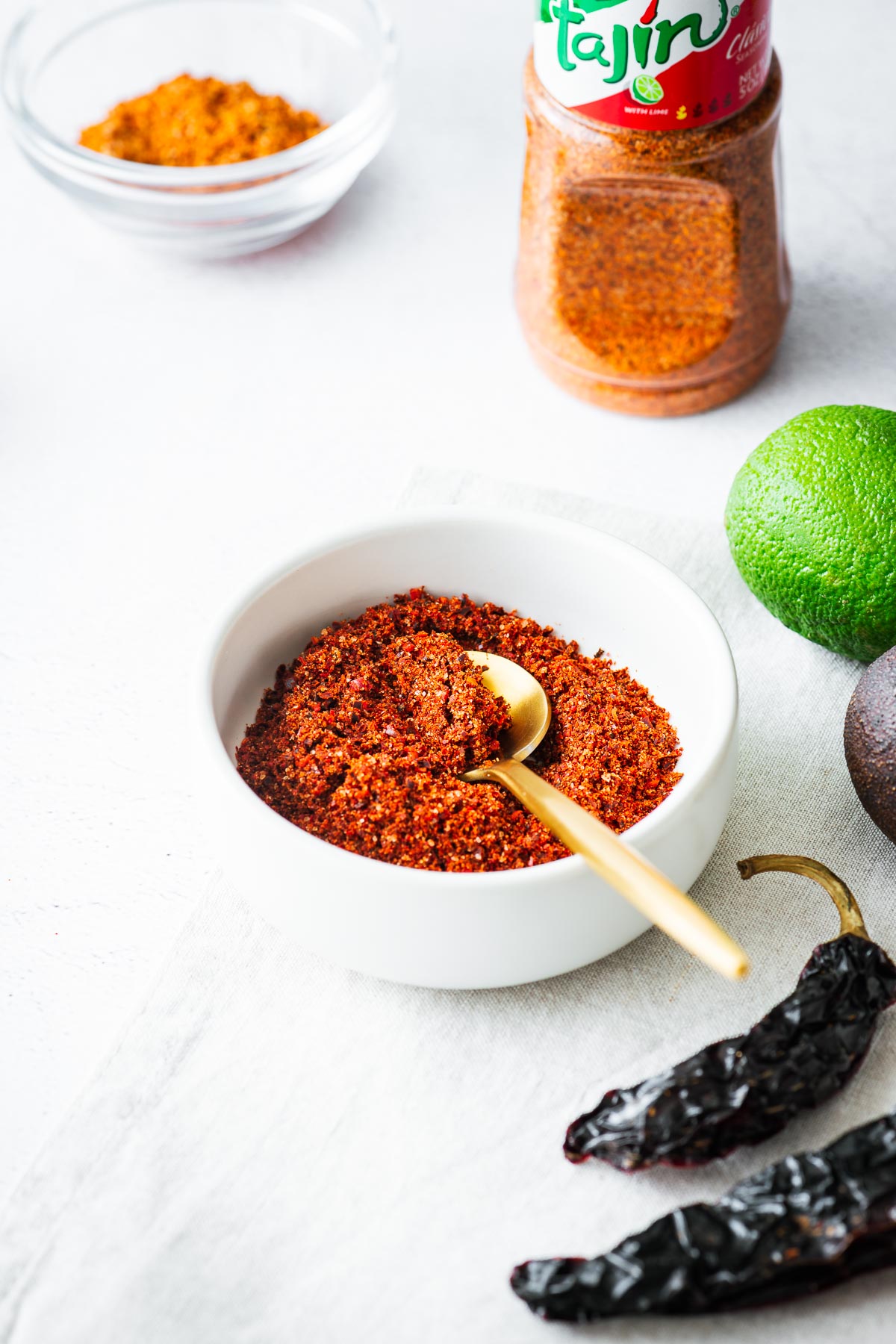
Frequently asked questions
Is Tajín Seasoning gluten-free?
Yes, the Tajín label information clearly states that the product is gluten-free. So does the official tajin website.
All of the tajin seasoning substitutes in this post are also gluten-free.
Does Tajín Seasoning contain sugar?
No, Tajín Clásico Seasoning has no added sugar. It is stated on the product ingredients label, as well as on the official tajin seasoning website.
All of the suggested tajin seasoning alternatives are also sugar-free.
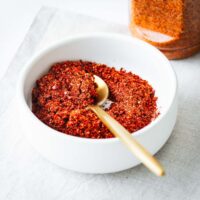
Ingredients
- 1 tablespoon mild chilli powder or fine flakes
- ¼ teaspoon smoked paprika (optional)
- ½ teaspoon ground sea salt
- ¼ teaspoon citric acid
- ¼ teaspoon ground black lime powder , lime zest, or dehydrated lime juice powder
Instructions
- If your chilli flakes are very coarse, grind the chilli mix in a spice grinder or mortar and pestle. Otherwise, add all the ingredients to a small bowl and mix well.
Notes
- Add the smoked paprika if your chilli flakes don’t have a smoky flavour.
- You can make ground black lime powder at home.
- If you don’t require a dry seasoning blend, you can also use lime juice instead of lime powder or zest to create a great Tajín substitute.

going to try making this w/o chili powder. will use smoked paprika the salt and lemon pepper. I have a maple pepper blend also that I may try. Altho, I live in Texas, I can’t eat any hot spices, hate chili, cumin, etc. Going to try to make creamed corn with this flavoring.
I think your smoked paprika blend will be delicious with creamed corn!
It’s “chili” not “chilli.” Your addition of the paprika is sheer genius.
Hi Teri, thank you so much for your kind words. You made my day!
“Chilli” is how “chili” is spelt outside the US in countries influenced by British English – like the UK, Australia and South Africa. But I have been contemplating adopting the American spelling for some words since most of my readers are in the US. And your comment just pushed me to start actioning that plan!